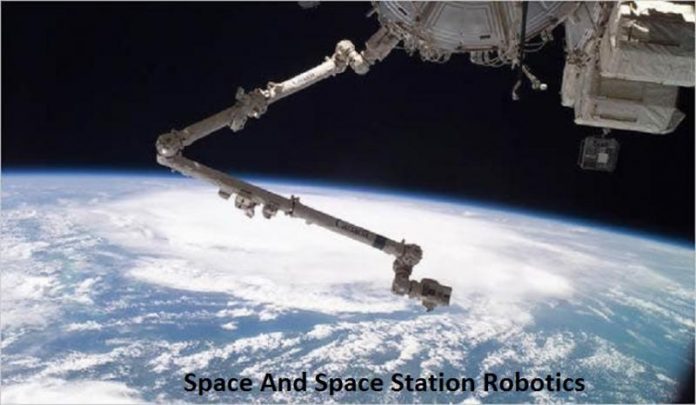Global Space and Space Station Robotics Market 2020-2024 examines the market in detail along with focusing on significant market dynamics for the key players in the market. This research report offers granulated yet in-depth analysis of revenue share, market segments, revenue estimates and various regions across the globe.
Global Space and Space Station Robotics Market overview:
Business Industry Reports Analyst covers the Major Players data, including: shipment, revenue, gross profit, interview record, business distribution etc., these data help the consumer know about the competitors better. This report also covers all the regions and countries of the world, which shows a regional development status, including market size.
Available Exclusive Sample Copy of this Report @ https://www.businessindustryreports.com/sample-request/270874 .
The Space and Space Station Robotics consists of three cubed-shaped robots, software and a docking station used for recharging. The robots use electric fans as a propulsion system that allows them to fly freely through the microgravity environment of the station. Cameras and sensors help them to “see” and navigate their surroundings. The Global Space and Space Station Robotics Market is segmented on the basis of Product Type, Application, End Use Industry and Region.
On the Basis of Product Type segment, the Space and Space Station Robotics Market is sub segmented into Microgravity Robots, Planetary Robotics and Others. Based on End Use Industry segment, the Space and Space Station Robotics Market is sub segmented into Aeronautics and Astronautics, Military and Others.
Some of the Space and Space Station Robotics Market manufacturers involved in the market are Maxar Technologies, Motiv Space Systems, Altius Space Machines, Northrop Grumman, Honeybee Robotics, Astrobotic Technology, Made In Space, Effective Space Solutions Limited in World; effective mergers are some of the strategies adopted by the Space and Space Station Robotics Market manufacturers. New product launches and continuous technological innovations are the Space and Space Station Robotics Market strategies adopted by the major players.
Purchase this report online with 90 Pages, List of Tables & Figures and in-depth Table of Contents on “Space and Space Station Robotics Market Report 2020” @ https://www.businessindustryreports.com/buy-now/270874/single .
The objective of the study is to define market sizes of different segments & countries in recent years and to forecast the values to the coming years. The report is designed to incorporate both qualitative and quantitative aspects of the industry within each of the regions and countries involved in the study.
There are several manufacturers of Space and Space Station Robotics in Europe and North America. In North America, the demand for Space and Space Station Robotics is primarily driven by the Space service sector. Among the countries in Asia Pacific, the demand was substantially high in developing countries such as China and India. These countries have been witnessing rapid increase in its population along with expansion of their overall economies, which has led to increase in disposable income.
Grab Your Report at an Impressive Discount @ https://www.businessindustryreports.com/check-discount/270874 .
Top Industry News:
Maxar Selected to Support Dynetics in Designing and Building a Lunar Human Landing System for NASA on 01 May, 2020 — Maxar Technologies, a trusted partner and innovator in Earth Intelligence and Space Infrastructure, today announced that it has been selected to support Dynetics, a wholly-owned subsidiary of Leidos, in designing and building a Human Landing System for NASA’s Artemis program, which will send the first woman and the next man to the Moon by 2024 and enable future crewed missions to Mars.
Dynetics’ Human Landing System will be designed to deliver two astronauts from lunar orbit to the lunar surface and back, including surface habitation for about a week. As part of the Dynetics team, Maxar will deliver a broad range of services and hardware solutions that will enable power, control, communications, robotic manipulation and thermal optimization for the Human Landing System. Maxar will also provide engineering and mission operations support.
Maxar’s role on Dynetics’ Human Landing System team expands the company’s significant contributions to NASA’s Artemis program. Maxar is developing the Power and Propulsion Element for the lunar Gateway that will enable a sustainable human deep-space presence in collaboration with international partners. And the company is building a robotic arm called SAMPLR for Masten Space Systems’ XL-1 unmanned lunar lander that will deliver nine technology demonstration experiments to the lunar south pole in 2022.
“Maxar is tremendously proud to contribute to these critical pieces of NASA’s Artemis program,” said Megan Fitzgerald, Maxar’s Senior Vice President and General Manager of Space Infrastructure. “By partnering with U.S. industry and leveraging innovative, flight-proven commercial technologies, NASA is accelerating this new era of American leadership in space.”
“Dynetics is excited to lead this expert team of subcontractors that will return Americans to the lunar surface,” said Kim Doering, Vice President of Space Systems at Dynetics. “This team has a proven history of technical excellence, and their contributions will greatly benefit the future of space exploration.”
Table of Contents:
1 Space and Space Station Robotics Product Definition
2 Global Space and Space Station Robotics Market Manufacturer Share and Market Overview
2.1 Global Manufacturer Space and Space Station Robotics Shipments
2.2 Global Manufacturer Space and Space Station Robotics Business Revenue
2.3 Global Space and Space Station Robotics Market Overview
3 Manufacturer Space and Space Station Robotics Business Introduction
3.1 Maxar Technologies Space and Space Station Robotics Business Introduction
3.1.1 Maxar Technologies Space and Space Station Robotics Shipments, Price, Revenue and Gross profit 2020-2024
3.1.2 Maxar Technologies Space and Space Station Robotics Business Distribution by Region
3.1.3 Maxar Technologies Interview Record
3.1.4 Maxar Technologies Space and Space Station Robotics Business Profile
3.1.5 Maxar Technologies Space and Space Station Robotics Product Specification
3.2 Motiv Space Systems Space and Space Station Robotics Business Introduction
3.2.1 Motiv Space Systems Space and Space Station Robotics Shipments, Price, Revenue and Gross profit 2020-2024
3.2.2 Motiv Space Systems Space and Space Station Robotics Business Distribution by Region
3.2.3 Interview Record
3.2.4 Motiv Space Systems Space and Space Station Robotics Business Overview
3.2.5 Motiv Space Systems Space and Space Station Robotics Product Specification
3.3 Altius Space Machines Space and Space Station Robotics Business Introduction
3.3.1 Altius Space Machines Space and Space Station Robotics Shipments, Price, Revenue and Gross profit 2020-2024
3.3.2 Altius Space Machines Space and Space Station Robotics Business Distribution by Region
3.3.3 Interview Record
3.3.4 Altius Space Machines Space and Space Station Robotics Business Overview
3.3.5 Altius Space Machines Space and Space Station Robotics Product Specification
3.4 Northrop Grumman Space and Space Station Robotics Business Introduction
3.5 HONEYBEE ROBOTICS Space and Space Station Robotics Business Introduction
3.6 Astrobotic Technology Space and Space Station Robotics Business Introduction
………………. Request free sample to get a complete Table of Content
About us
BusinessindustryReports.com is digital database of comprehensive market reports for global industries. As a market research company, we take pride in equipping our clients with insights and data that holds the power to truly make a difference to their business. Our mission is singular and well-defined – we want to help our clients envisage their business environment so that they are able to make informed, strategic and therefore successful decisions for themselves.
Media Contact
Business Industry Reports
Pune – India
sales@businessindustryreports.com
+19376349940
This release was published on openPR.














